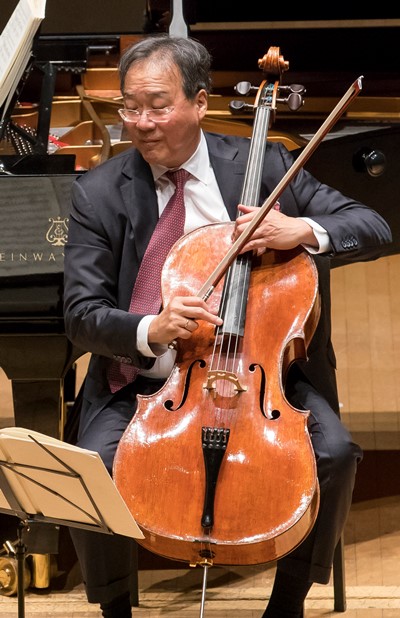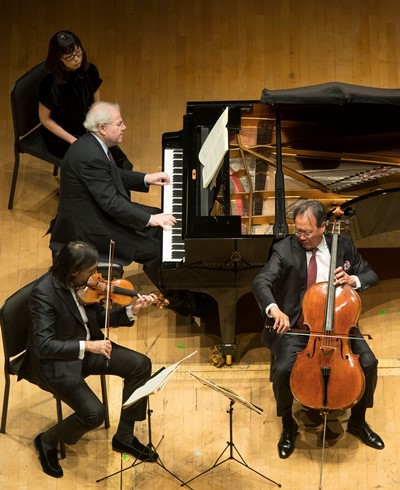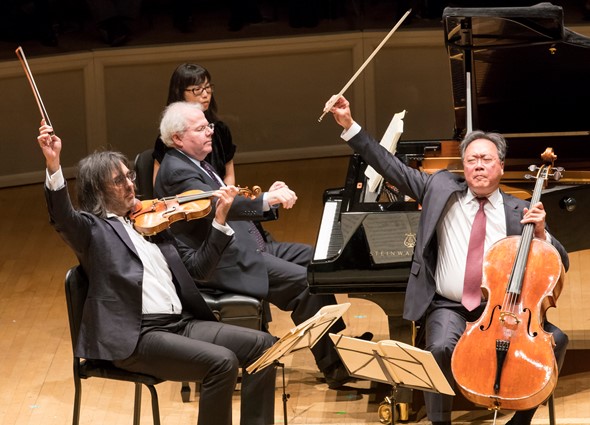Brahms’ three trios for violin, cello and piano, played in perfect completeness by three stars
Review: The Brahms piano trios. Violinist Leonidas Kavakos, cellist Yo-Yo Ma and pianist Emanuel Ax. On Feb. 25 at Orchestra Hall.
By Lawrence B. Johnson
Even if it wasn’t literally a once in a lifetime experience, it was rare enough, and it surely was special: the opportunity to hear all three of Brahms’ piano trios performed in a single concert by musicians who brought long careers and stellar artistry to bear on those formidable works.
Violinist Leonidas Kavakos, cellist Yo-Yo Ma and pianist Emanuel Ax converged on the Brahms trios before an overflow audience at Orchestra Hall that spilled onto stage seating. The event in the Symphony Center Presents series delivered all that one might have wished for, and then some.
 In a manner of speaking, Brahms composed four piano trios – if you count the earliest of them twice, first as the work of a 20-year-old and then in its thoroughly rewritten form by a composer in his mid-fifties at the summit of his powers. Even in its transfigured form, that work, the Piano Trio in B, retained the designation Op. 8. Brahms famously quipped that it should be renumbered Op. 108. A monumental essay, it was held for last in this comprehensive survey.
In a manner of speaking, Brahms composed four piano trios – if you count the earliest of them twice, first as the work of a 20-year-old and then in its thoroughly rewritten form by a composer in his mid-fifties at the summit of his powers. Even in its transfigured form, that work, the Piano Trio in B, retained the designation Op. 8. Brahms famously quipped that it should be renumbered Op. 108. A monumental essay, it was held for last in this comprehensive survey.
Thus Kavakos, Ma and Ax began with Trio No. 2 in C, Op. 87, written over the years 1880-82, or between the Second and Third Symphonies.
The Trio in C major – cast, like its companions, in four movements — immediately testifies to the virtuoso pianist that Brahms must have been, and to his flair for deriving high drama from just three players. In these hands, the outer movements surged with a kind of elemental power.
But one might argue that the most fetching music of Op. 87 lies between those chapters of late-Romantic Sturm und Drang: in the ghostly quality of its second-movement scherzo and, especially, in the ensuing variations on a theme of Hungarian gypsy profile. Here, violinist, pianist and cellist imbued the variations with an irresistible blend of vibrancy and sensuality.
 If the Op. 87 Trio displays a grand frame, its successor, the Trio in C minor, Op. 101, well might be characterized as a symphony writ small. Dating from 1886, the year after Brahms had finished the last of his four symphonies, the C minor Trio essentially picks up where the Fourth Symphony left off, though it harkens back to the pastoral spirit and beauty of Brahms’ Second Symphony.
If the Op. 87 Trio displays a grand frame, its successor, the Trio in C minor, Op. 101, well might be characterized as a symphony writ small. Dating from 1886, the year after Brahms had finished the last of his four symphonies, the C minor Trio essentially picks up where the Fourth Symphony left off, though it harkens back to the pastoral spirit and beauty of Brahms’ Second Symphony.
Here, Ax provided the harmonic ground work for luxurious string playing by Kavrakos and Ma, the three together generating a symphonic sonority that belied the mere three figures who occupied center stage. The middle movements of Op. 101 point back to a different antecedent: Brahms’ Third Symphony, with its elegant interior episodes. These three musicians captured the gossamer essence of Trio’s scherzo as well as the fragile textures of the Andante grazioso.
If there is any piano trio in the repertoire that can stand shoulder to shoulder with Beethoven’s Trio in B-flat, Op. 97 (“Archduke”) in terms of sheer majesty as well as intellectual depth, it is Brahms’ reconstruction of his youthful Trio in B, Op. 8. Thirty-five years had elapsed from the genesis of the work to the time Brahms decided to rethink it; and while he didn’t simply discard the original structure, his remodeling took it back to the studs and subflooring.
 What Kavakos, Ma and Ax delivered was fully the brilliant, rigorous, dramatically charged new work that Brahms had fashioned from, as it were, the early Op. 8 as basis, blueprint. The performance exulted in both the heat of its intensity and the fluency of its ensemble interplay. I couldn’t help thinking of a previous generation and the great collaborations of Jascha Heifetz, Gregor Piatigorsky and Arthur Rubinstein.
What Kavakos, Ma and Ax delivered was fully the brilliant, rigorous, dramatically charged new work that Brahms had fashioned from, as it were, the early Op. 8 as basis, blueprint. The performance exulted in both the heat of its intensity and the fluency of its ensemble interplay. I couldn’t help thinking of a previous generation and the great collaborations of Jascha Heifetz, Gregor Piatigorsky and Arthur Rubinstein.
Here again – in Leonidas Kavakos, Emanuel Ax and Yo-Yo Ma — were three star soloists performing like a well-conditioned chamber ensemble. High-powered, masterful, eloquent playing all around, and Brahms at its revelatory center.
Tags: Emanuel Ax, Leonidas Kavakos, Yo-Yo Ma


